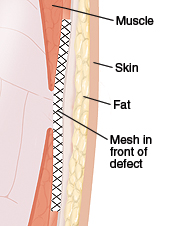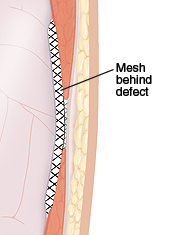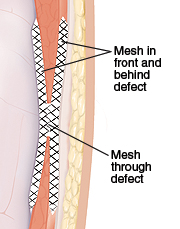Having Hernia Surgery: Patch Repair
Having Hernia Surgery: Patch Repair
Surgery treats a hernia by repairing the weakness in the abdominal wall. An incision is made so the surgeon has a direct view of the hernia. The repair is then done through this incision (open surgery). To repair the defect, special mesh materials are used to patch the weak area and make a “tension-free repair.” Follow your healthcare provider’s advice on how to get ready for the procedure. You can usually go home the same day as your surgery. In some cases, though, you may need to stay in the hospital overnight.
Getting ready for surgery
Your healthcare provider will talk with you about preparing for surgery. Follow all the instructions you’re given and be sure to:
Tell your healthcare provider about any medicines, supplements, or herbs you take. This includes both prescription and over-the-counter items.
Stop taking aspirin, ibuprofen, naproxen and other NSAIDs as directed.
Arrange for an adult family member or friend to give you a ride home after surgery.
Stop smoking. Smoking affects blood flow and can slow healing.
Gently wash the surgical area the night before surgery.
Follow any directions you are given for not eating or drinking before surgery.
|
|
|
|
The day of surgery
Arrive at the hospital or surgical center at your scheduled time. You’ll be asked to change into a patient gown. You’ll then be given an IV to provide fluids and medicine. Shortly before surgery, an anesthesiologist or nurse anesthetist will talk with you. He or she will explain the types of anesthesia used to prevent pain during surgery. You will have one or more of the following:
Monitored sedation to make you relaxed and sleepy.
Local anesthesia to numb the surgical site.
Regional anesthesia to numb specific areas of your body.
General anesthesia to let you sleep during surgery.
During the surgery
Most hernias are treated using “tension-free” repairs. This is surgery that uses special mesh materials to repair the weak area. Unlike traditional repairs, the abdominal fascia (tissue around the muscle that gives strength to the abdominal wall) isn’t sewn together. Instead, the mesh covers the weak area like a patch. This repairs the defect without “tension” on the muscles. It also makes it less likely to happen again. The mesh is made of strong, flexible plastic that stays in the body. Over time, nearby tissues grow into the mesh to strengthen the repair.
After surgery
When the procedure is over, you’ll be taken to the recovery area to rest. Your blood pressure and heart rate will be monitored. You’ll also have a bandage over the surgical site. To help reduce discomfort, you’ll be given pain medicines. You may also be given breathing exercises to keep your lungs clear. Later, you’ll be asked to get up and walk. This helps prevent blood clots in the legs. You can go home when your healthcare provider says you’re ready.
Risks and complications
Hernia surgery is safe, but does have risks including:
|
|
Updated:
July 10, 2017
Sources:
Anatomy of the Abdominal Wall. UpToDate, Overview of abdominal wall hernias in adults. UpToDate, Overview of treatment for inguinal and femoral hernia in adults. UpToDate
Reviewed By:
Freeborn, Donna, PhD, CNM, FNP,Image reviewed by StayWell medical illustration team.,Lehrer, Jenifer, MD


